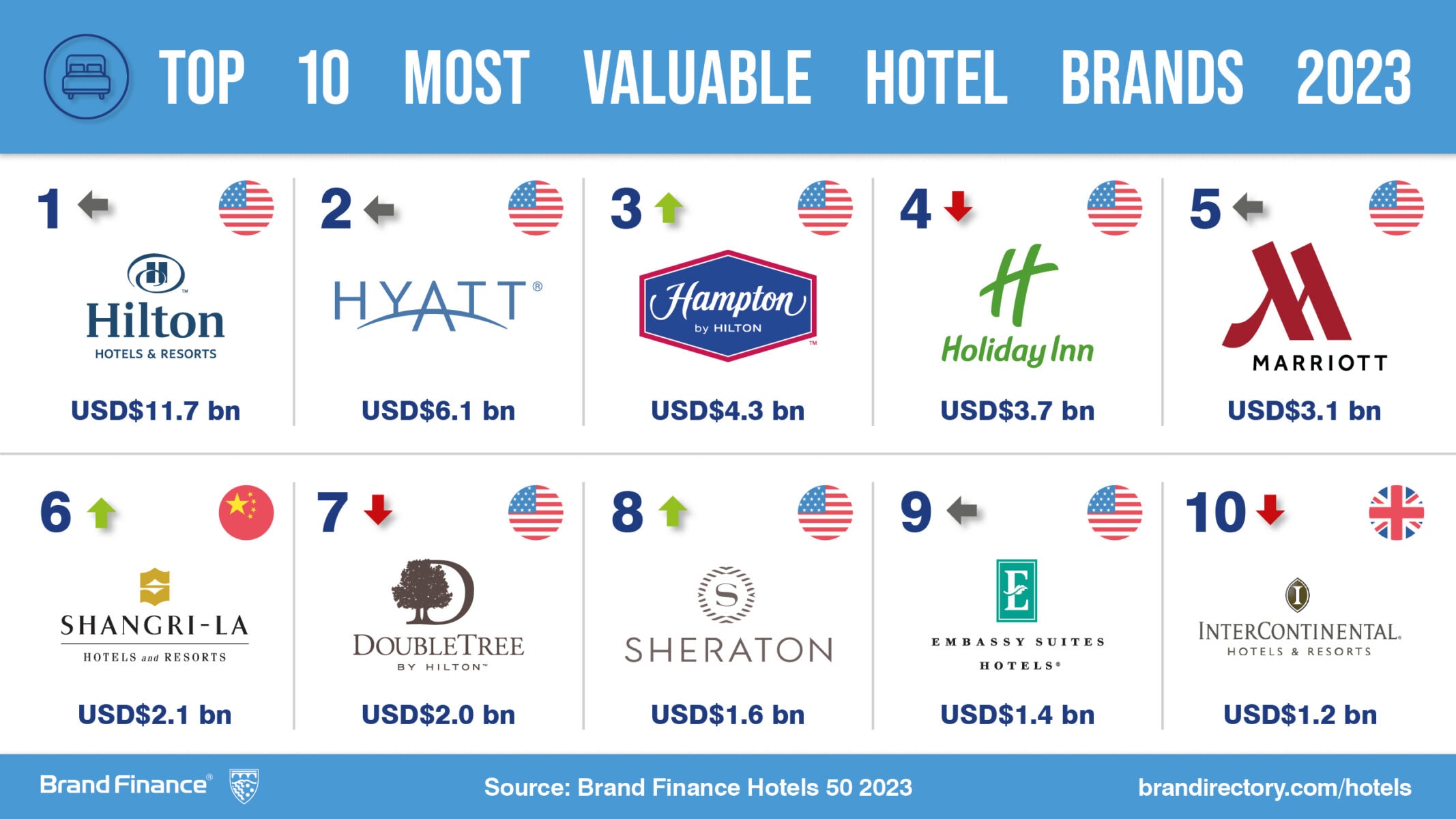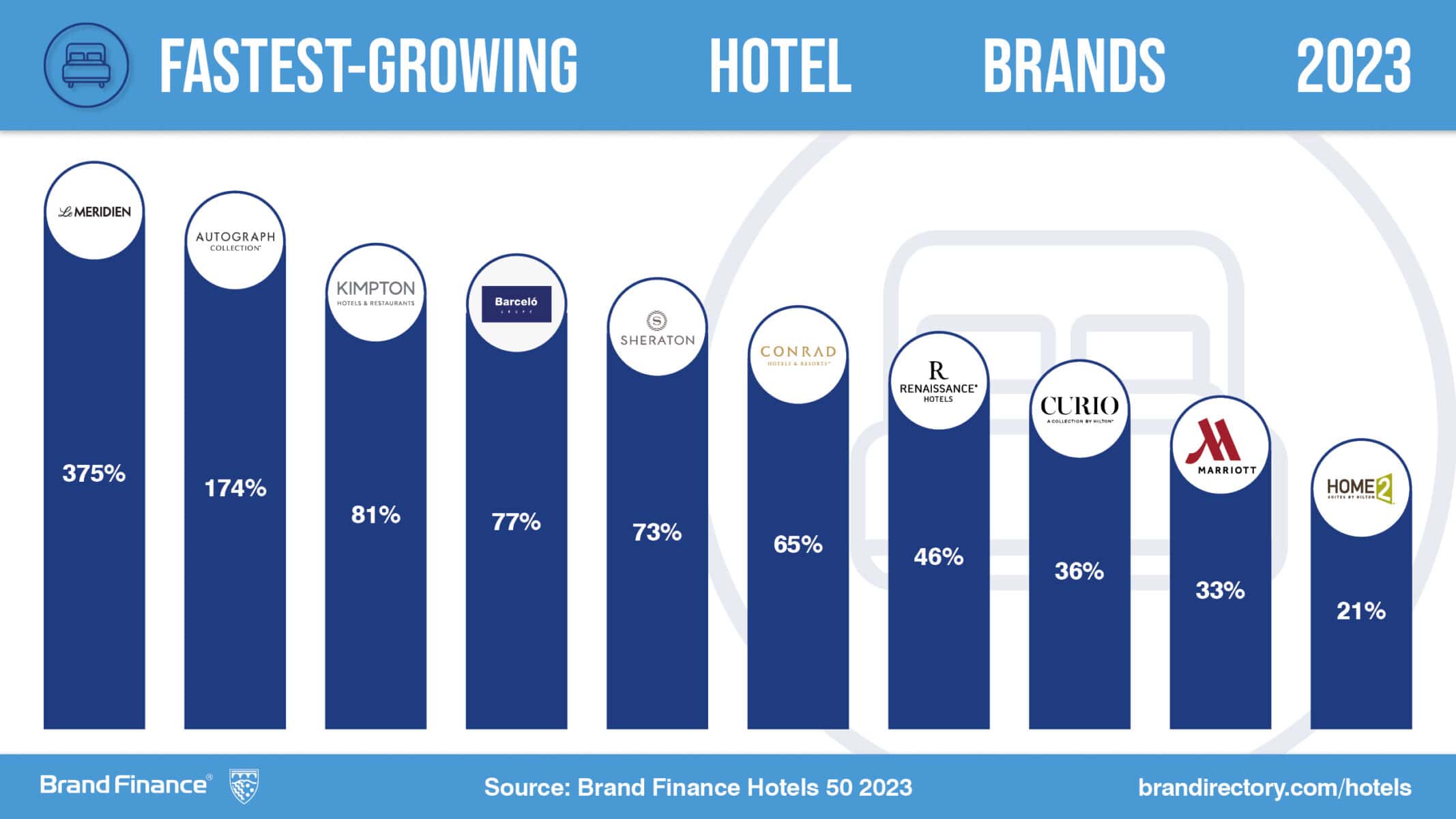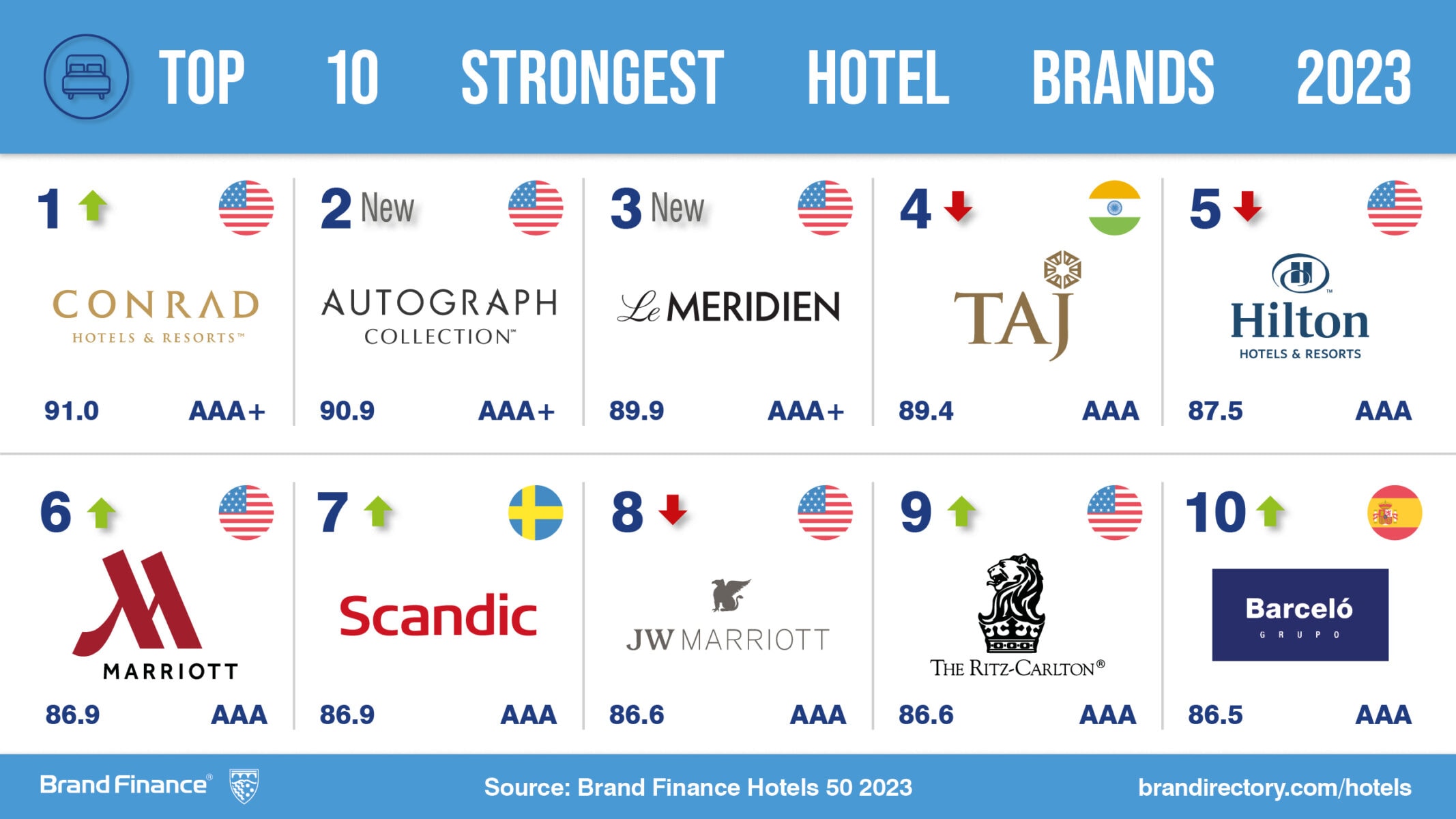View the full Brand Finance Hotels 50 report here
After two years of global travel restrictions and economic uncertainty, the past year has witnessed an increasing return to pre-pandemic travel patterns. However, Brand Finance research finds that the hotel industry is slow to recover from the pandemic’s long-lasting effects, as 27 out of 50 hotel brands (54%) remain below their pre-pandemic values.
Hilton (brand value down 2% to US$11.7 billion) retains its title as the world’s most valuable hotel brand, according to the latest report from leading brand valuation consultancy, Brand Finance. 2022 was an exceptional year of brand value growth for Hilton, with revenue soaring as both business and leisure travel surged post-pandemic. This year’s result indicates a slight slowdown in this growth momentum, as the industry returns to a more normal trajectory. That said, Hilton’s brand value remains above its pre-pandemic level, and it is almost double that of runner-up, Hyatt (brand value up 3% to US$6.1 billion).
Henry Farr, Associate Director at Brand Finance, commented,
“In the post-pandemic world, Hilton has demonstrated remarkable resilience and a steadfast commitment to delivering exceptional experiences. With an unwavering focus on guest satisfaction, Hilton has not only recovered but has emerged stronger in several aspects, solidifying its position as a leading global brand. Through innovative strategies and a dedication to shifting consumer needs, it has retained its title as the world’s most valuable hotel brand.”

Le Méridien (brand value up 375% to US$669.4 million) checks into the 2023 top 50 ranking in 23rd as the fastest-growing hotel brand. Part of the Marriott (brand value up 33% to US$3.1 billion) International portfolio, Le Méridien has been expanding its presence across the globe in the past year. Most recently, Le Méridien established Le Méridien Melbourne. Its premium location and luxury features have attracted both tourists and locals, further boosting the hotel’s revenue from bookings in one of Australia’s most popular coastal cities. Other significant growth milestones for Le Méridien include its second hotel opening in New York City, which is hoped to boost its familiarity score in the US and globally.

In addition to calculating brand value, Brand Finance also determines the relative strength of brands through a balanced scorecard of metrics evaluating marketing investment, stakeholder equity, and business performance. Compliant with ISO 20671, Brand Finance’s assessment of stakeholder equity incorporates original market research data from over 100,000 respondents in 38 countries and across 31 sectors.
Conrad (brand value up 65% to US$537.82 million) has jumped up 16 spots to 31st position overall, while jumping an astonishing 38 spots into the winning position for brand strength, scoring 91/100. Known for its luxurious options and personalised service, Conrad has boosted its brand strength this year through significant global expansion. Hilton opened six new Conrad Hotels and Resorts in various desirable locations, including LA and Shanghai, with the aim of enhancing its long-standing reputation for seamless luxury and exceptional hotel design.

As part of its analysis, Brand Finance assesses the role that specific brand attributes play in driving overall brand value. One such attribute, is sustainability. Brand Finance assesses how sustainable specific brands are perceived to be, represented by a ‘Sustainability Perceptions Score’. This is an indexed score that provides a view of the role of sustainability in driving positive brand reputation. The value that is linked to sustainability perceptions, the ‘Sustainability Perceptions Value’, is then calculated for each brand.
Hilton has the highest Sustainability Perceptions Value (SPV) at US$565 million. Although Hilton has committed to becoming more sustainable, its position at the top of the SPV table is not an assessment of its overall sustainability performance. Rather, it indicates how much brand value it has tied up in sustainability perceptions. Hilton's commitment to sustainability is evident through its ESG program, Travel with Purpose. The brand has set ambitious targets, aiming to reduce emissions intensity by 75% in Hilton-managed hotels and 56% in Hilton-franchised hotels by 2030.
India based hotels group, Taj (brand value up 19% to US$374.35 million) earns the highest Sustainability Perceptions Score in the Hotels 50 2023 ranking at 5.04 out of 10. In 2022, Taj's parent company, IHCL, launched the Paathya sustainability programme, encompassing several key initiatives, including eliminate the use of single-use plastics across its hotels, and installing electric vehicle (EV) charging stations.

Brand Finance is the world’s leading brand valuation consultancy. Bridging the gap between marketing and finance, Brand Finance evaluates the strength of brands and quantifies their financial value to help organisations make strategic decisions.
Headquartered in London, Brand Finance operates in over 25 countries. Every year, Brand Finance conducts more than 6,000 brand valuations, supported by original market research, and publishes over 100 reports which rank brands across all sectors and countries.
Brand Finance also operates the Global Brand Equity Monitor, conducting original market research annually on 6,000 brands, surveying more than 175,000 respondents across 41 countries and 31 industry sectors. By combining perceptual data from the Global Brand Equity Monitor with data from its valuation database — the largest brand value database in the world — Brand Finance equips ambitious brand leaders with the data, analytics, and the strategic guidance they need to enhance brand and business value.
In addition to calculating brand value, Brand Finance also determines the relative strength of brands through a balanced scorecard of metrics evaluating marketing investment, stakeholder equity, and business performance, compliant with ISO 20671.
Brand Finance is a regulated accountancy firm and a committed leader in the standardisation of the brand valuation industry. Brand Finance was the first to be certified by independent auditors as compliant with both ISO 10668 and ISO 20671 and has received the official endorsement of the Marketing Accountability Standards Board (MASB) in the United States.
Brand is defined as a marketing-related intangible asset including, but not limited to, names, terms, signs, symbols, logos, and designs, intended to identify goods, services, or entities, creating distinctive images and associations in the minds of stakeholders, thereby generating economic benefits.
Brand strength is the efficacy of a brand’s performance on intangible measures relative to its competitors. Brand Finance evaluates brand strength in a process compliant with ISO 20671, looking at Marketing Investment, Stakeholder Equity, and the impact of those on Business Performance. The data used is derived from Brand Finance’s proprietary market research programme and from publicly available sources.
Each brand is assigned a Brand Strength Index (BSI) score out of 100, which feeds into the brand value calculation. Based on the score, each brand is assigned a corresponding Brand Rating up to AAA+ in a format similar to a credit rating.
Brand Finance calculates the values of brands in its rankings using the Royalty Relief approach – a brand valuation method compliant with the industry standards set in ISO 10668. It involves estimating the likely future revenues that are attributable to a brand by calculating a royalty rate that would be charged for its use, to arrive at a ‘brand value’ understood as a net economic benefit that a brand owner would achieve by licensing the brand in the open market.
The steps in this process are as follows:
1 Calculate brand strength using a balanced scorecard of metrics assessing Marketing Investment, Stakeholder Equity, and Business Performance. Brand strength is expressed as a Brand Strength Index (BSI) score on a scale of 0 to 100.
2 Determine royalty range for each industry, reflecting the importance of brand to purchasing decisions. In luxury, the maximum percentage is high, while in extractive industry, where goods are often commoditised, it is lower. This is done by reviewing comparable licensing agreements sourced from Brand Finance’s extensive database.
3 Calculate royalty rate. The BSI score is applied to the royalty range to arrive at a royalty rate. For example, if the royalty range in a sector is 0-5% and a brand has a BSI score of 80 out of 100, then an appropriate royalty rate for the use of this brand in the given sector will be 4%.
4 Determine brand-specific revenues by estimating a proportion of parent company revenues attributable to a brand.
5 Determine forecast revenues using a function of historic revenues, equity analyst forecasts, and economic growth rates.
6 Apply the royalty rate to the forecast revenues to derive brand revenues.
7 Discount post-tax brand revenues to a net present value which equals the brand value.
Brand Finance has produced this study with an independent and unbiased analysis. The values derived and opinions presented in this study are based on publicly available information and certain assumptions that Brand Finance used where such data was deficient or unclear. Brand Finance accepts no responsibility and will not be liable in the event that the publicly available information relied upon is subsequently found to be inaccurate. The opinions and financial analysis expressed in the study are not to be construed as providing investment or business advice. Brand Finance does not intend the study to be relied upon for any reason and excludes all liability to any body, government, or organisation.
The data presented in this study form part of Brand Finance's proprietary database, are provided for the benefit of the media, and are not to be used in part or in full for any commercial or technical purpose without written permission from Brand Finance.